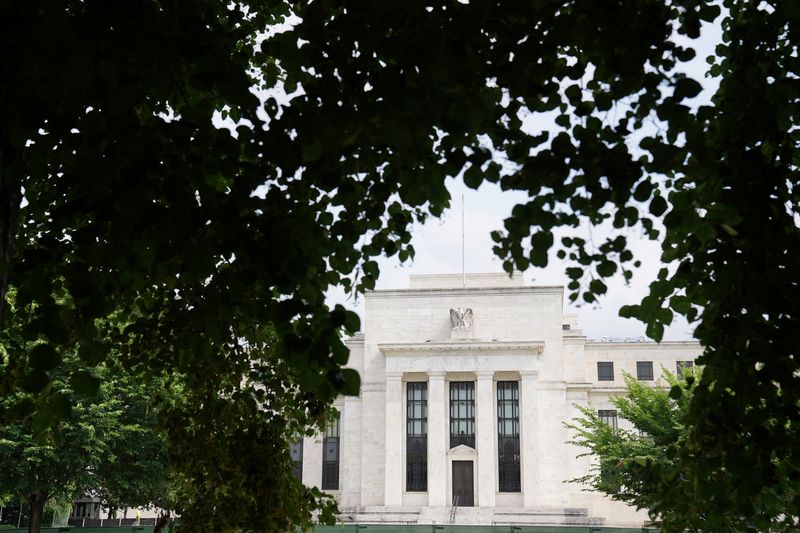Investing.com – While a "substantial majority" of Federal Reserve policymakers backed the central bank's jumbo rate cut in September, there were signs that some members preferred to kick off the rate cutting cycle with a more modest cut on worries about the strength of the economy, according to the minutes of the Federal Reserve’s Sept. 17-18 meeting, released Wednesday.
At the conclusion of its previous meeting on Sept. 18, the Federal Open Market Committee, or FOMC, reduce its benchmark rate by 50 basis points to a range of 4.75% to 5%, marking the first rate cut since 2020.
Substantial majority of Fed members backed jumbo cut on signs that hot inflation in Q1 was transitory
"A substantial majority of participants supported lowering the target range for the federal funds rate by 50 basis points to 4-3/4 to 5 percent," the Fed minutes showed. The members believed that a larger cut would help "bring it into better alignment with recent indicators of inflation and the labor market."
In support of the decision to cut rates, many participants were encouraged by the softer inflation data in second and third quarter, which suggested "the stronger-than-anticipated inflation readings in the first quarter had been only a temporary interruption of progress toward 2 percent," the minutes showed.
Minutes show some members preferred smaller cut in September
While Federal Reserve Governor Michelle Bowman was the lone dissenter, preferring to lower rates by just 25bps, the minutes signaled that some members were also wary somewhat of kicking off the rate cutting cycle with a half point cut.
"Noting that inflation was still somewhat elevated while economic growth remained solid and unemployment remained low, some participants observed that they would have preferred a 25 basis point reduction of the target range at this meeting, and a few others indicated that they could have supported such a decision," the minutes added.
On the outlook for rate cuts, members expected that "if the data came in about as expected, with inflation moving down sustainably to 2 percent and the economy near maximum employment, it would likely be appropriate to move toward a more neutral stance of policy over time."
Adding to credence of the case for a smaller cut 25 basis point reduction, the minutes reflected that several participants noted that a smaller rate cut would be in line with a "gradual path of policy normalization that would allow policymakers time to assess the degree of policy restrictiveness as the economy evolved."
A few members, however, believed that the path of where interest rate are headed rather than the size of the cut at the September meeting would be more "important in determining the degree of policy restriction."
At the meeting, the Fed's summary of economic projections, or SEPs, showed that Fed members changed their forecast on rate cuts. They estimated the need for another 50 basis points of cuts compared with a prior estimate in June for just one cut, with several further cuts, which would eventually take the central bank's benchmark rate to 2.9% in 2026.
On the labor market, several participants acknowledged that supply and demand in the labor market was roughly in balance, estimating that wage increases were "unlikely to be a source of general inflation pressures in the near future."
But a lot has changed since that Sept. Fed meeting.
Stronger economic data dent rate-cut bets ease following September meeting
Data pointing to a stronger-than-expected labor market signaling strength in the economy has unnerved bets on further jumbo rate cuts, with some even questioning whether the central bank could pause its rate cutting cycle.
"The market is now pricing fewer rate cuts than the Fed's projections, which is a significant shift from just a few weeks ago," UBS strategists said in a Tuesday note.
Following the strong September jobs report, however, some Fed members continued to back further rate cuts, welcoming the strength in the labor market as sign the economy remains on track for a soft landing.
"Right now, I think monetary policy is well positioned for the outlook, and if you look at the SEP projections that capture the totality of the views, it's a very good base case with an economy that’s continuing to grow and inflation coming back to 2%." New York Fed President John Williams said on Tuesday.
Markets had a muted reaction to the minutes, with broader market holding onto the bulk of gains as traders continue to markets expectations for a 25 basis point at the Fed November meeting was largely unchanged.
"After the minutes, markets reduced the odds of a November 25bp cut to 75% from 87%, raising the odds of no cut to 25%, an overreaction as the Federal Reserve's rhetoric isn't hawkish," Oxford Economics said in a note.
